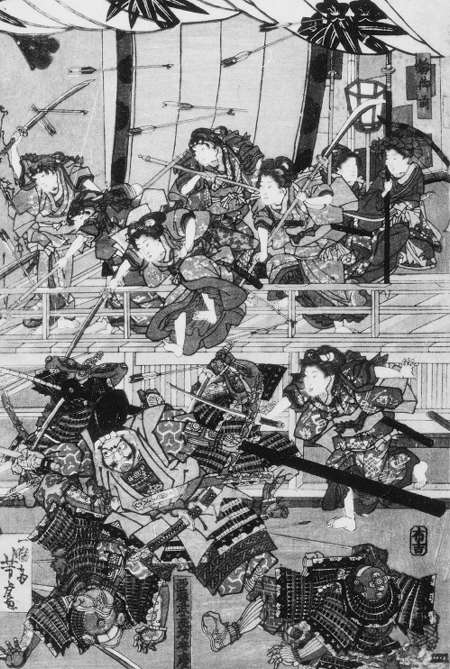The Role of the Arms-Bearing Women in Japanese History
The Warring States Period

From the tenth century on, Japan can never be said to have been at peace. But in 1467, the whole country was swept into chaos in what became known as the Sengoku Jidai (Warring States Period, circa 1467 c.e. through 1568 c.e.). It was a time in which all social classes were swept up into war. Feudal domains were sometimes stripped of almost all healthy men, who hired themselves out as nobushi (mercenaries), were drafted into armies, or slaughtered in battle. As a result of this rampant warfare, women were often the last defense of towns and castles.
In this period there are accounts of the wives of warlords, dressed in flamboyant armor, leading bands of women armed with naginata. In an account in the Bichi Hyoranki, for example, the wife of Mimura Kotoku, appalled by the mass suicide of the surviving women and children in her husband’s besieged castle, armed herself and led eighty-three soldiers against the enemy, “whirling her naginata like a waterwheel.” She challenged a mounted general, Ura Hyobu, but he refused, claiming that women were unfit as opponents to true warriors. He edged backwards in cowardice, saying under his breath, “She is a demon!” She refused to back down, but while his soldiers attacked her, he escaped. She cut through her attackers and won her way back to the castle.
It was probably at this time that the image of women fighters with naginata arose. However, as Yazawa Isao, a sixteenth-generation headmistress of Toda-ha Buko-ryu wrote (in 1916), the main weapon of most women in these horrible times was not the naginata, but the kaiken, which Bushi women carried at all times. Yazawa stated that a woman was not usually expected to fight with her dagger. Instead, she was required to kill herself in a manner as wrapped in custom as the male warrior’s seppuku. This was known as jigai. In seppuku, a man was required to show his stoicism in the face of unimaginable pain by disemboweling himself. In jigai, women had a method in which death would occur relatively quickly. The nature of the wound was not likely to cause an ugly distortion of the features or disarrangement of the limbs that would offend the woman’s dignity after death. The dagger was used to cut the jugular vein.
Women did not train in using the kaiken with sophisticated combat techniques. If a woman was forced to fight, she was to grab the hilt with both hands, plant the butt firmly against her stomach, and run forward to stab the enemy with all her weight behind the blade. She was to become, for a moment, a living spear. She was not supposed to boldly draw her blade and challenge her enemy. She had to find some way to catch him unawares. If she were successful in this, she would most likely be unstoppable. More often than not, however, a woman could not expect to face a single foe nor, even then, to have the advantage of surprise. If she were captured alive, even after killing several enemies, she would be raped, displayed as a captive, or otherwise dishonored. In the rigid beliefs of this period, women would thereby allow shame to attach to their name. The only escape from what was believed to be disgrace was death at one’s own hands.
The Edo Period: An Enforced Peace
In the mid-seventeenth century, when Japan finally arrived at an enforced peace under the authoritarian rule of the Tokugawa shogunate, the need for skill at arms decreased. The turbulent energies of the warrior class were restrained by an intricate code of conduct based upon laws governing behavior appropriate to each level of society. The rough codes of earlier warriors were codified into the doctrines of bushido–the “way of the warrior.” Self-sacrifice, honor, and loyalty became fixed ideals, focusing the energies of the warrior class on a new role as governing bureaucrats and police agents in a society under an enforced, totalitarian peace. The role of the warrior was mythologized, and certain images held up as ideals for all to emulate. That these doctrines were primarily a Confucian political ideology rather than a way for active warriors to survive is shown by the fact that the original reference to these codes was “shido” (in Chinese, the way of the “gentleman”), a direct reference to Confucian concepts.
Everyone was required to fill an immutable role in society, fixed at birth and held until death. The rules and social conventions governing conduct between men and women, formerly somewhat more egalitarian, became more rigid than in any other period of Japanese history. A woman’s relationship towards her husband was said to mirror that of a samurai towards his lord. The bushi woman was expected to center her life around her home, serving her family in the person of her husband first, his sons second, and her mother-in-law third. Studies and strong physical activity were considered unseemly. Work was almost completely gender divided, and the lives of men and women became increasingly separate from one another. There was usually a room in each house reserved for men which women were forbidden to enter, even to clean or serve food. Husbands and wives did not even customarily sleep together. The husband would visit his wife to initiate any sexual activity and afterwards would retire to his own room.
The stories of women warriors defending their homes and their families became means to define a woman’s role in society. They trained with the naginata less to prepare for combat than to instill them with the idealized virtues necessary to be a samurai wife. A women’s work was unremitting service to the males of the household and tireless effort to teach proper behavior to her children, who were legally considered to be her husband’s alone. However, unlike the upper-class women of Victorian England, who were expected to be subservient and frail, the bushi women were expected to be subservient and strong. Their duty was to endure.
When a bushi woman married, one of the possessions that she took to her husband’s home was a naginata. Like the daisho (long and short swords) that her husband bore, the naginata was considered an emblem of her role in society. Practice with the naginata was a means of merging with a spirit of self-sacrifice, of connecting with the hallowed ideals of the warrior class. As men were expected to sacrifice themselves for the state and the maintenance of society, women were expected to sacrifice themselves to a rigid, limited life in the home.1 No longer carried on the battlefield,2 the use of the naginata was confined to practice with wooden replicas in the many martial traditions.
In the mostly peaceful years of the Edo period, martial systems often fissioned, each faction specializing in one or another weapon. Many schools focusing on the use of the naginata were created and began to be increasingly associated with women.
In some villages, women maintained an active role in maintaining order. The mother of one of my instructors told how when she was a small girl in a village in Kyushu, the southernmost major island of Japan, men were often gone from the village in certain seasons to join up on labor crews. When there was a disturbance at night or a suspicious character entered the village, the women would grab their naginata, which hung ready on one of the walls of the house, and go running outside to gather and search the town for any danger. Her grandmother was the leader of this “emergency response squad,” and they were a naturally autonomous group within the village. Protecting the neighborhood was simply assumed to be one of their functions.
Copyright ©2002 Ellis Amdur. All rights reserved.
[Part 1 | Part 2 | Part 3 | Part 4 | Part 5]
- In a book published in the early 1970s, a master instructor of the Takenouchi-ryu writes that the women of the Takenouchi family trained with naginata and learned self-defense when they were young. As adults, they were “…very busy taking care of the house and had little time to practice. However, when bringing tea to the dojo for the male students, they had an opportunity to listen to the teacher’s instructions and pick up some of the movements that they saw being practiced” from Takenouchi-ryu Hensan I-in Kai, in Takenouchi-ryu, p. 104. ↩︎
- Statistics from a 1764 inspection of a feudal domain in what is now modern-day Okayama show that the castle had 3,787 muskets and its retainers had another 4,698 muskets and 1,265 hunting guns. Three thousand three hundred and sixteen spears were kept at the castle and another 5,010 distributed among the retainers. Only fifty naginata were counted in this survey. ↩︎
This article first appeared in Journal of Asian Martial Arts, vol. 5, no. 2, 1996. It has been extensively revised for inclusion in Old School: Essays on Japanese Martial Traditions.
